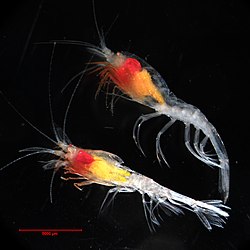| Hymenodora glacialis | |
|---|---|
 | |
| Scientific classification | |
| Kingdom: | |
| Phylum: | |
| Subphylum: | |
| Class: | |
| Order: | |
| Infraorder: | |
| Family: | |
| Genus: | |
| Species: | H. glacialis |
| Binomial name | |
| Hymenodora glacialis | |
Hymenodora glacialis, commonly known as the Northern deep-sea shrimp or the Northern ambereye, [2] is a species of pelagic shrimp in the Acanthephyridae family. It is the only known species of pelagic shrimp to inhabit the Canada Basin. [3]
H. glacialis was described in 1874 by Buchholz.